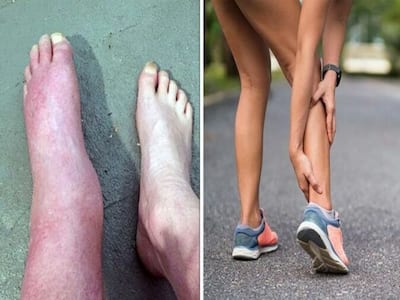
Are you suffering from fatty liver disease? Here is one sign which can tel you the hidden truth.
The liver is one of the most important organs of the body. The organ is crucial for detoxification, controlling most blood chemical levels, and bile excretion. The liver receives all the blood that exits the intestines and stomach. It is the largest internal organ in our body and can have function issues when one suffers from fatty liver disease. We spoke to Dr Sukhvinder Singh Saggu, Director, Minimal Access, GI, and Bariatric Surgery, CK Birla Hospital (R), Delhi, to understand how one can understand if their liver is not working properly.
What Is Fatty Liver Disease?
Fatty liver disease is a serious condition that can occur due to excessive accumulation of fat in the liver, leading to its dysfunction. The liver, being the largest internal organ in the human body, plays a vital role in various metabolic processes. However, when the liver is affected by this disease, it can have life-threatening consequences. There can be several reasons behind the build-up of excess fat in the liver.
What Are The Symptoms of Fatty Liver Disease
Walking is a difficult motion that requires the body’s muscles and joints to work together. The liver plays an important role in this process by producing bile, which is necessary for the digestion and absorption of fats. When the liver is damaged by fatty liver disease, its ability to produce bile is compromised, which can have several effects on the body including body movement.
The symptoms of fatty liver disease can vary. These consist of:
- Pain or bloating in the abdomen
- Vomiting, appetite loss, or weight loss
- Eyes turning white and skin turning yellow
- Swollen legs and abdomen
- Physical and mental exhaustion
- Weakness
How does a person’s walk help in identifying fatty liver disease?
People with fatty liver disease may experience weakness, stiffness, or pain in their legs and feet. They may also have difficulty maintaining their balance and coordination, which can cause them to alter their walking style. People with fatty liver disease may walk with a shuffling gait, taking small, hesitant steps instead of striding confidently. They may also tend to lean forward or to one side, which can throw off their balance and increase their risk of falling. Additionally, they may have trouble lifting their feet off the ground, which can cause them to drag their feet and trip over obstacles.
READ RELATED: Starbucks' New CEO Admits The Chain's Food "Could Use More Work"
It is important to note that while changes in walking style may be a potential sign of fatty liver disease, not all individuals with the condition exhibits this symptom. In fact, some people with fatty liver disease may not experience any symptoms at all. On the other hand, some individuals may experience may suffer from more severe symptoms, such as liver failure, which can be life-threatening. It is important to recognize that the symptoms of fatty liver disease can vary widely and to seek medical attention if one is experiencing any signs of liver dysfunction.
How To Reduce The Risk of Fatty Liver?
Fatty liver disease occurs when there is an accumulation of fat in the liver. While it can be caused by excessive alcohol consumption, non-alcoholic fatty liver disease (NAFLD) is increasingly becoming common due to lifestyle choices such as a poor diet and lack of exercise.
To reduce the risk of developing fatty liver, managing weight through regular exercise and a balanced diet is important. Consuming foods rich in Omega-3 fatty acids can help to reduce inflammation in the liver. Limiting or avoiding alcohol altogether is also recommended, as alcohol can cause inflammation and damage to the liver. Monitoring blood sugar, triglyceride, and cholesterol levels is also essential, as high levels of these substances can contribute to fatty liver. Aim for at least 30 minutes of moderate exercise five days a week, as this can help to reduce the risk of fatty liver and maintain overall health. Finally, focusing on a balanced diet that includes plenty of fruits, vegetables, whole grains, lean proteins, and healthy fats can help to reduce the risk of fatty liver disease.
Changes in walking style can be a subtle but important sign of fatty liver disease. While not everyone with the condition will experience these changes, they can be an indication that something is not right with the liver. If you are concerned about your liver health, it is important to speak with the doctor and take steps to maintain a healthy lifestyle. By doing so, one can reduce their risk of developing fatty liver disease and improve their overall health and well-being.
Total Wellness is now just a click away.
Follow us on
window.addEventListener(‘load’, (event) => {
// $(document).ready(function(){
$(‘#commentbtn’).on(“click”,function(){
(function(d, s, id) { var js, fjs = d.getElementsByTagName(s)[0]; if (d.getElementById(id)) return; js = d.createElement(s); js.id = id; js.src = “//connect.facebook.net/en_US/sdk.js#xfbml=1&version=v2.3”; fjs.parentNode.insertBefore(js, fjs);}(document, ‘script’, ‘facebook-jssdk’));
$(“.cmntbox”).toggle();
});
// });
});








